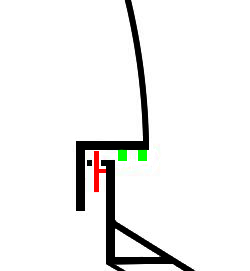

I tested my third solution to my first leak by turning the rear of the shutter (where it sits when open) towards the wind when we were expecting high winds and heavy rain one night. I covered the telescope and mount with a plastic sheet in case the rain came in. The next morning I found a small pool of water on the floor under the edge of the dome adjacent to the rear of the shutter opening. I couldn't understand how it could have got there from the top of the dome and, in any case, there was no sign of water on the plastic sheet.
I sent a message to the Observatories Yahoo Group about it, and one of their members responded that it was amazing how wind-blown rain could get into almost any structure and suggesting that it came in under the dome. This made me look more carefully at the way the dome is made and how it was fitted to the roof of my observatory. Since the dome has to rotate, a complete seal to the walls is obviously impossible.
 This diagram is meant to show how the dome is constructed and how it fits into the roof of my observatory. I must emphasise that it is purely diagrammatic and not drawn to scale. The dome itself and the vertical wall are provided by the manufacturer. The short wall carries the wheels that support the dome and also some more horizontal wheels that ensure that it stays on track. These can be seen in the picture here. One support wheel is shown in red on my diagram because its presence is relevant to the story of how I think the water got in. For most of its circumference the dome only overhangs the walls by a very small amount (maybe 10 mm or less) and there is a rubber strip stuck on that overhang so that any water draining down the dome drips off rather than running under the dome and through the gap shown in the diagram. This tape is continued round the outside of the extra overhang where the shutter is and should also be put across in line with the rest of the tape round the dome. These two strips of tape are shown in my diagram in green.
This diagram is meant to show how the dome is constructed and how it fits into the roof of my observatory. I must emphasise that it is purely diagrammatic and not drawn to scale. The dome itself and the vertical wall are provided by the manufacturer. The short wall carries the wheels that support the dome and also some more horizontal wheels that ensure that it stays on track. These can be seen in the picture here. One support wheel is shown in red on my diagram because its presence is relevant to the story of how I think the water got in. For most of its circumference the dome only overhangs the walls by a very small amount (maybe 10 mm or less) and there is a rubber strip stuck on that overhang so that any water draining down the dome drips off rather than running under the dome and through the gap shown in the diagram. This tape is continued round the outside of the extra overhang where the shutter is and should also be put across in line with the rest of the tape round the dome. These two strips of tape are shown in my diagram in green.
In my case, the piece of tape on the left in my diagram had not been stuck on properly and left a gap. What I believe happened is that the sloping roof caused the wind to blow rain up onto the underside of the overhang and in under the dome through this gap in the tape. As it happens there is a support wheel in that area so there is a hole in the horizontal part of the wall structure through which the water drained straight down onto my floor. Had the wheel not been there, the water would still have come through between the horizontal part of the wall and the internal vertical part of the dome, but exactly where would have been uncertain.
Hopefully I have cured the problem by replacing the tape that was missing. I will check it out next time we have rain and strong winds. At the very least I can say that my second idea to prevent the first leak worked well.
Home Equipment Observatory Page 1 Page 2 Page 3 Page 4 Page 6